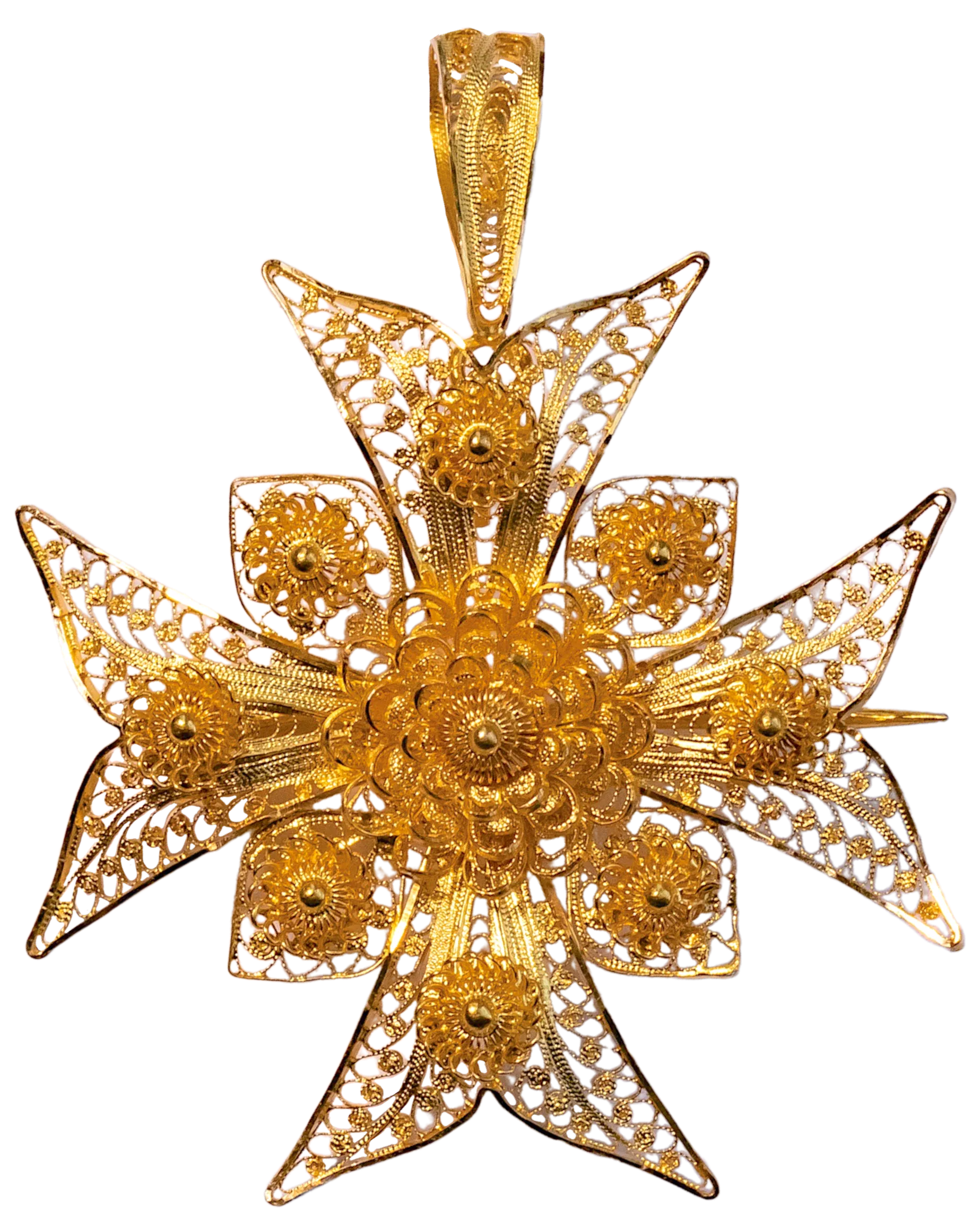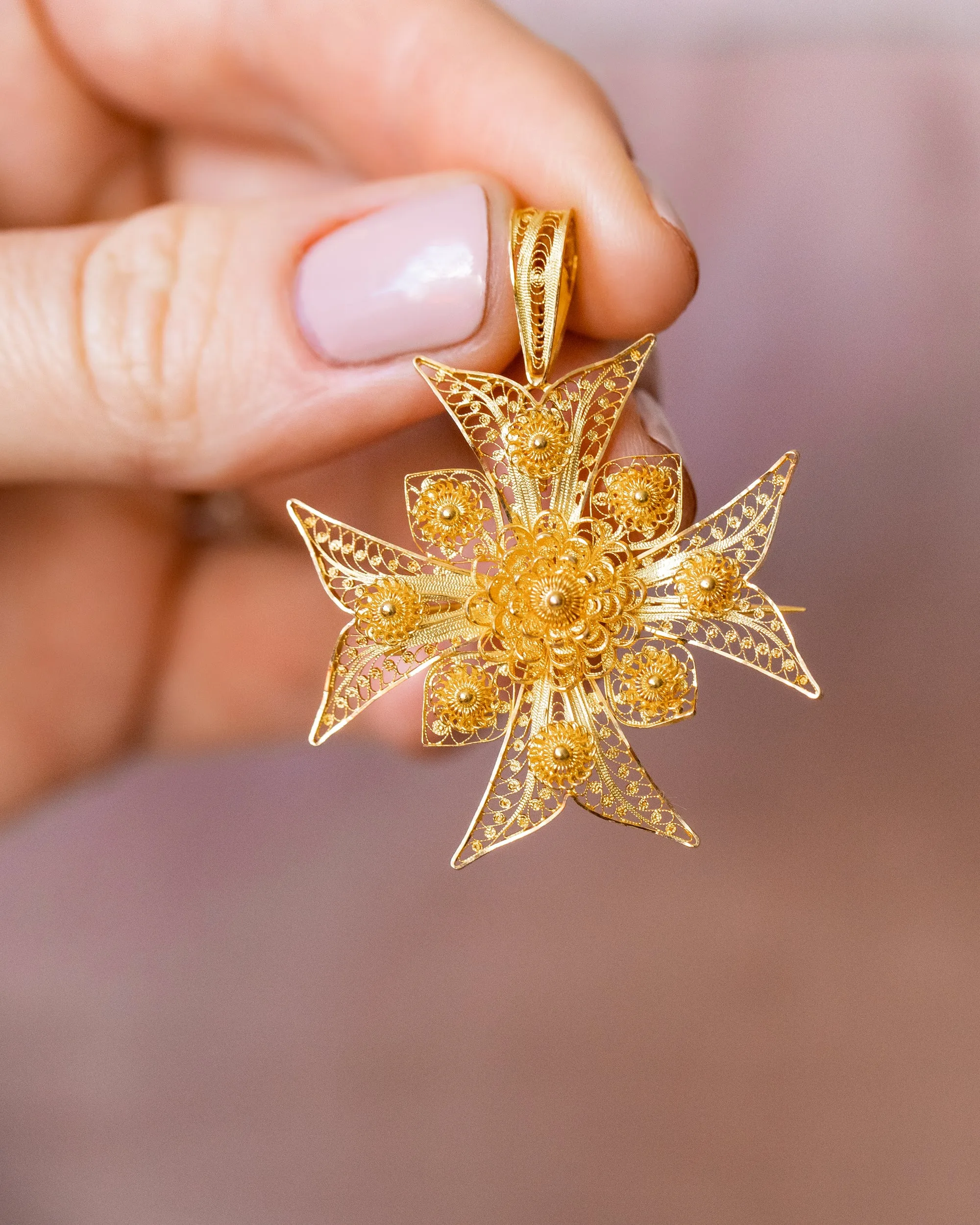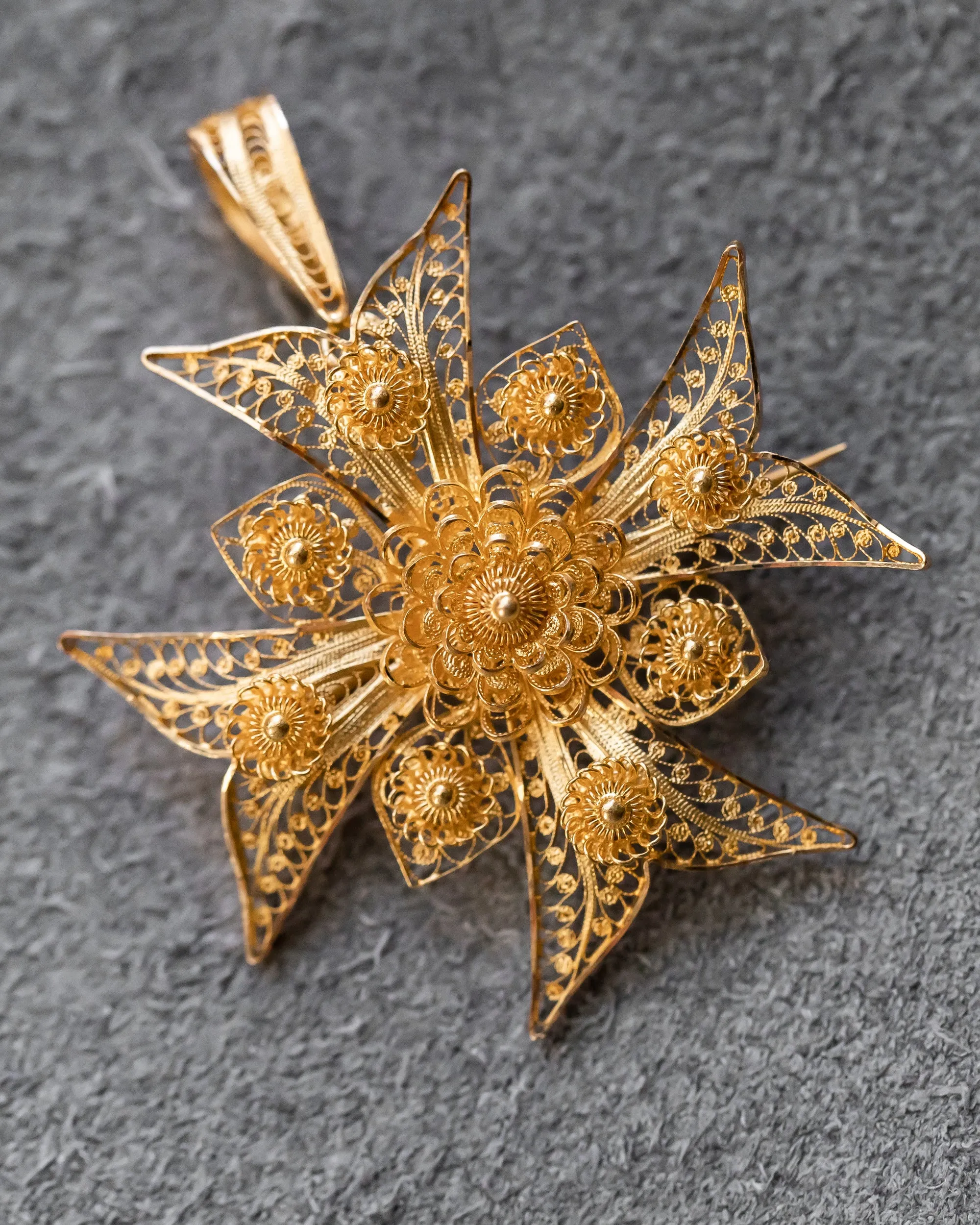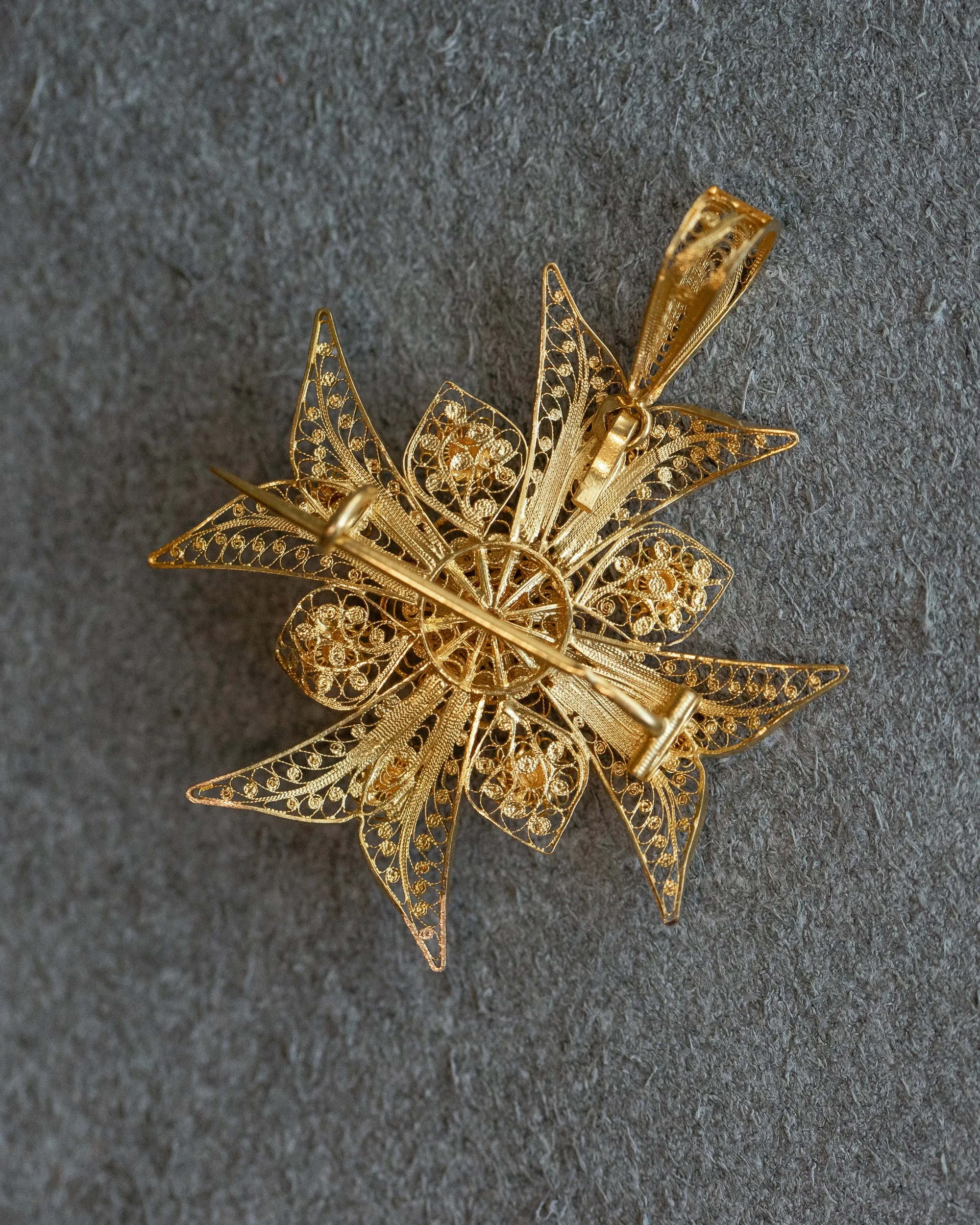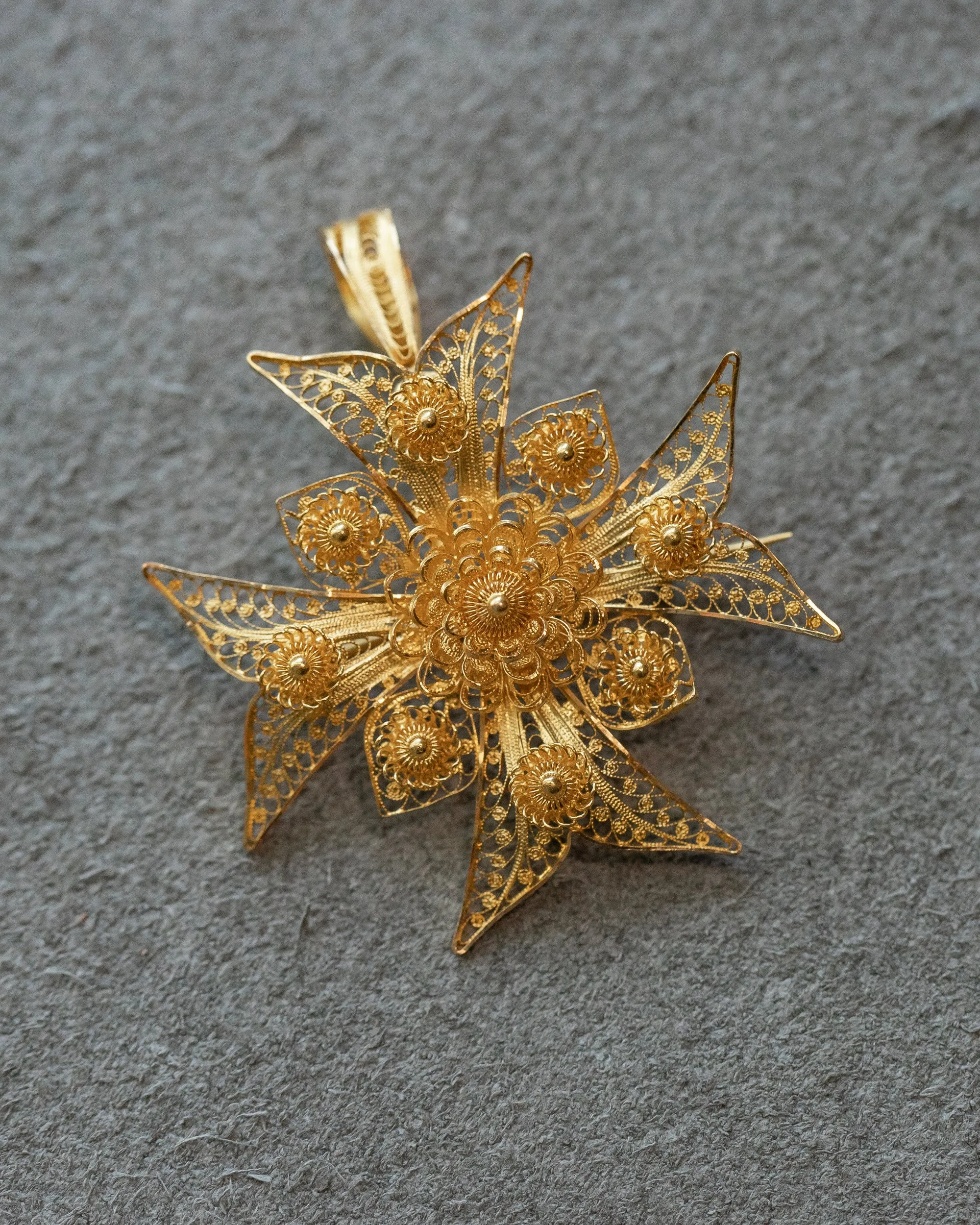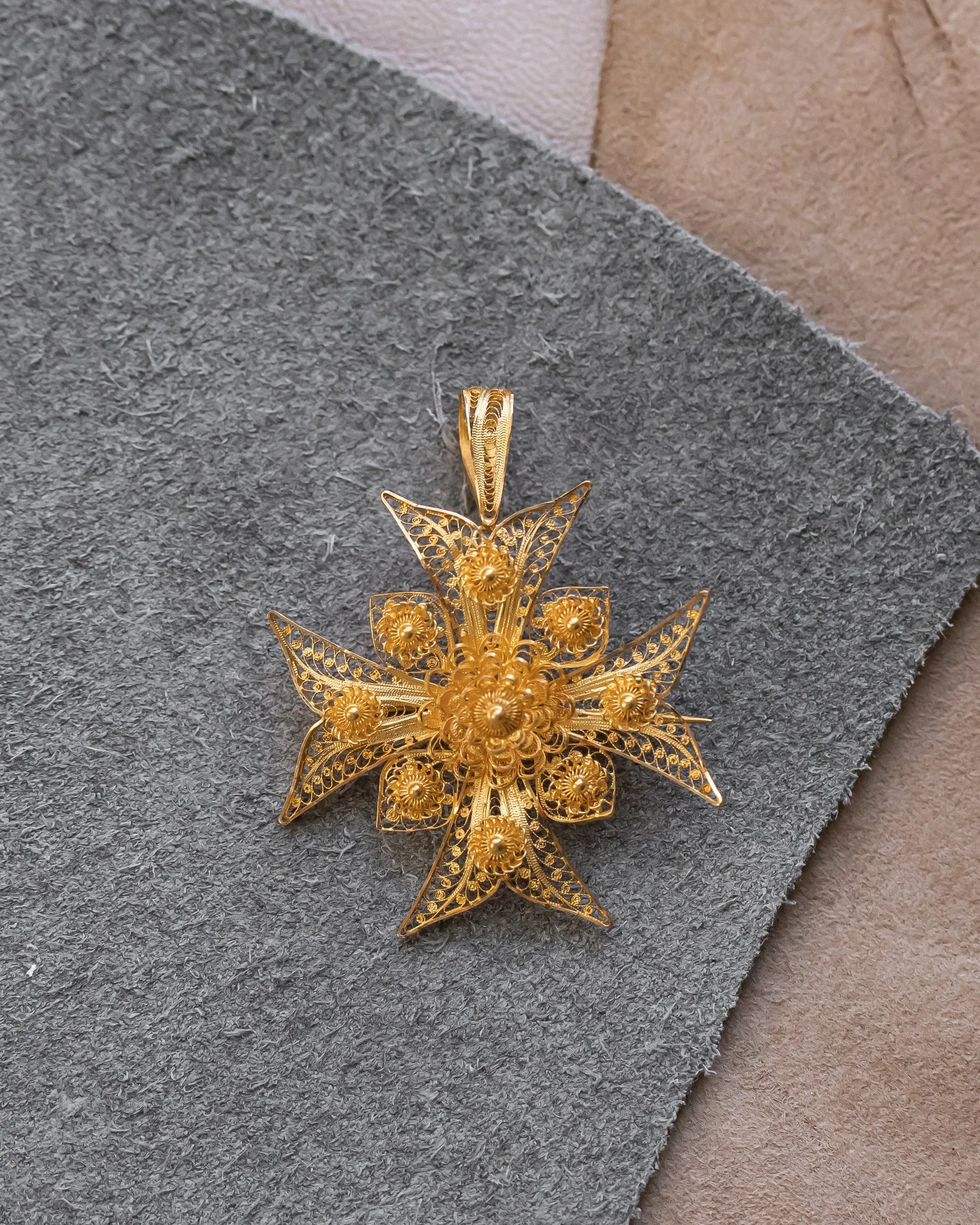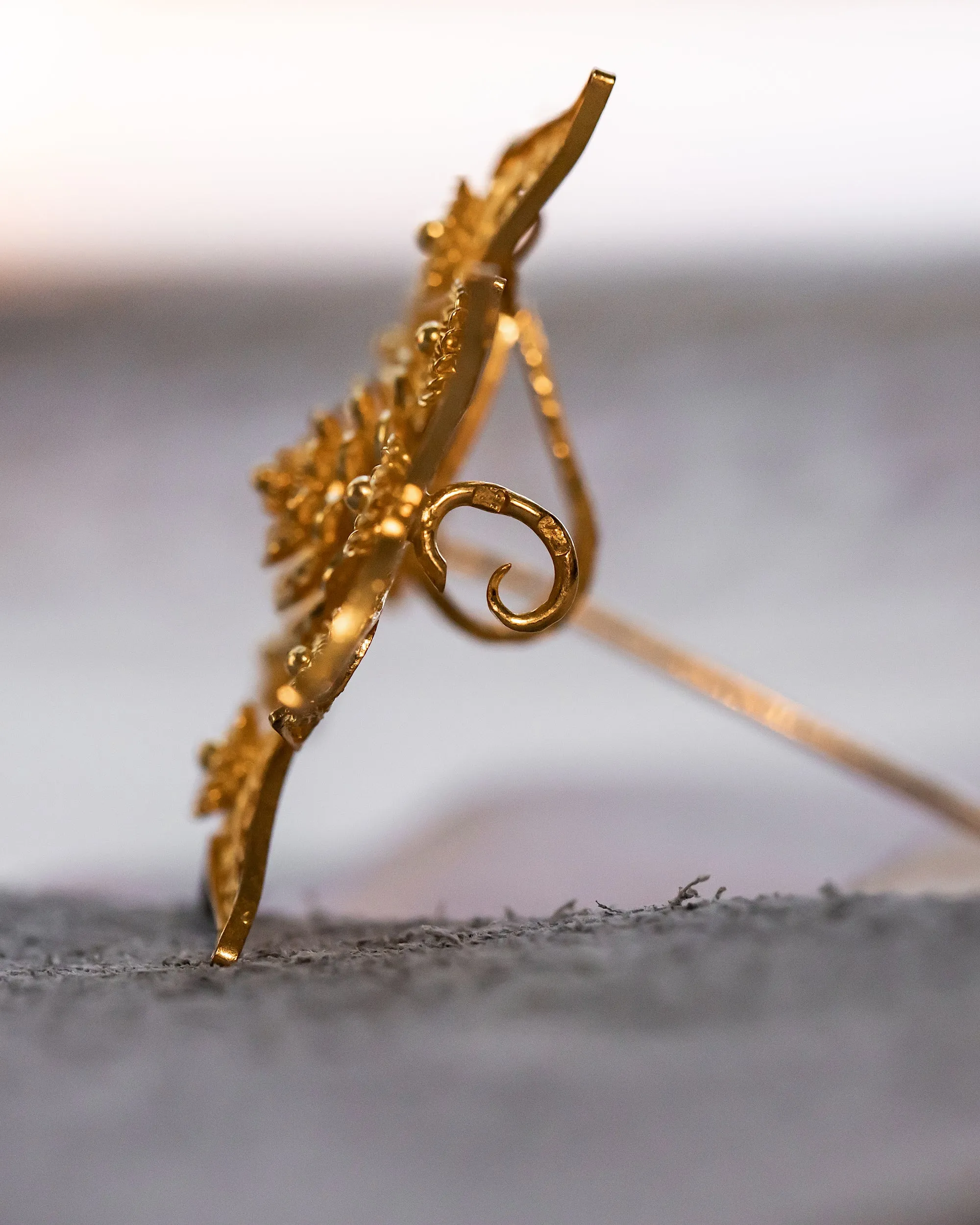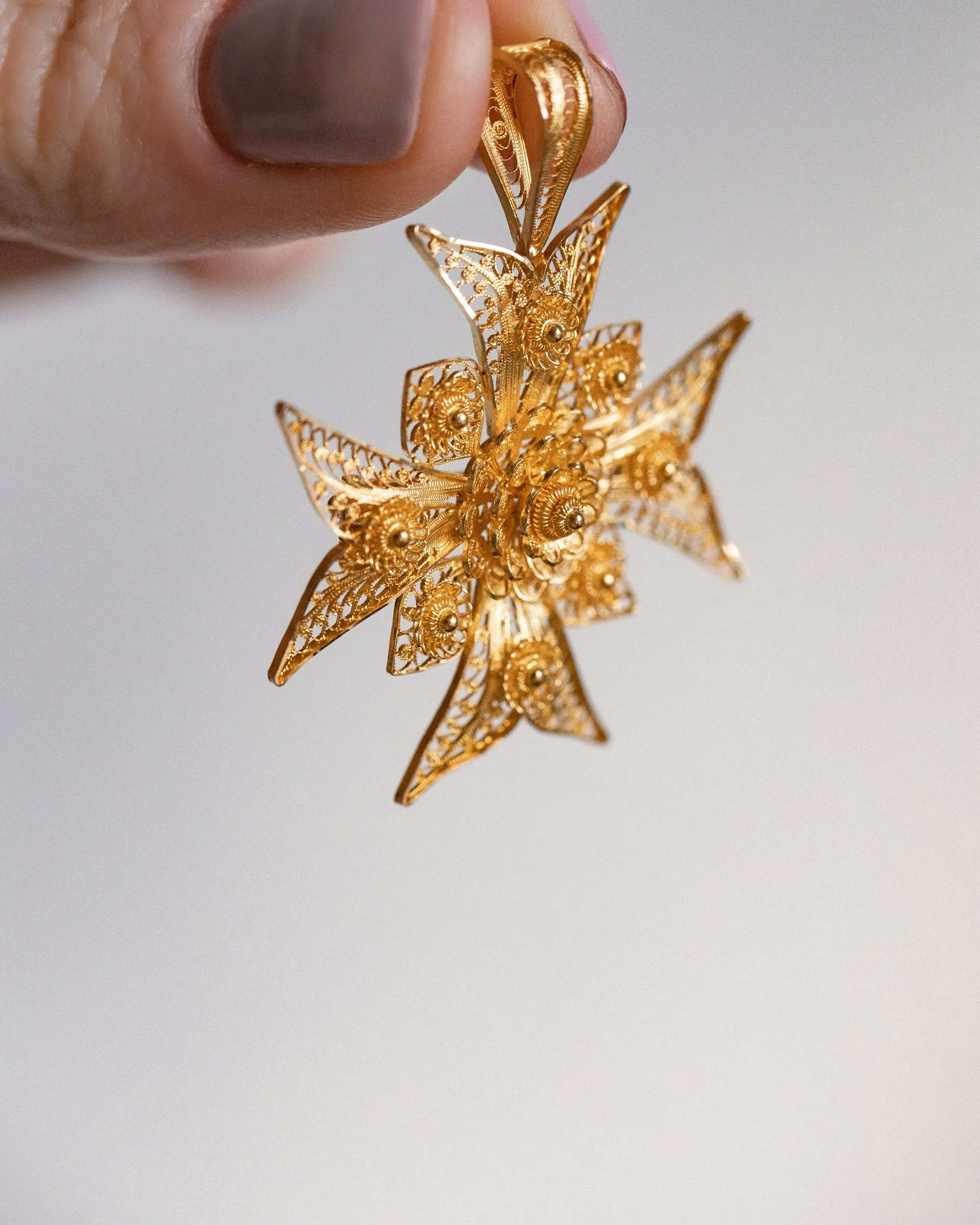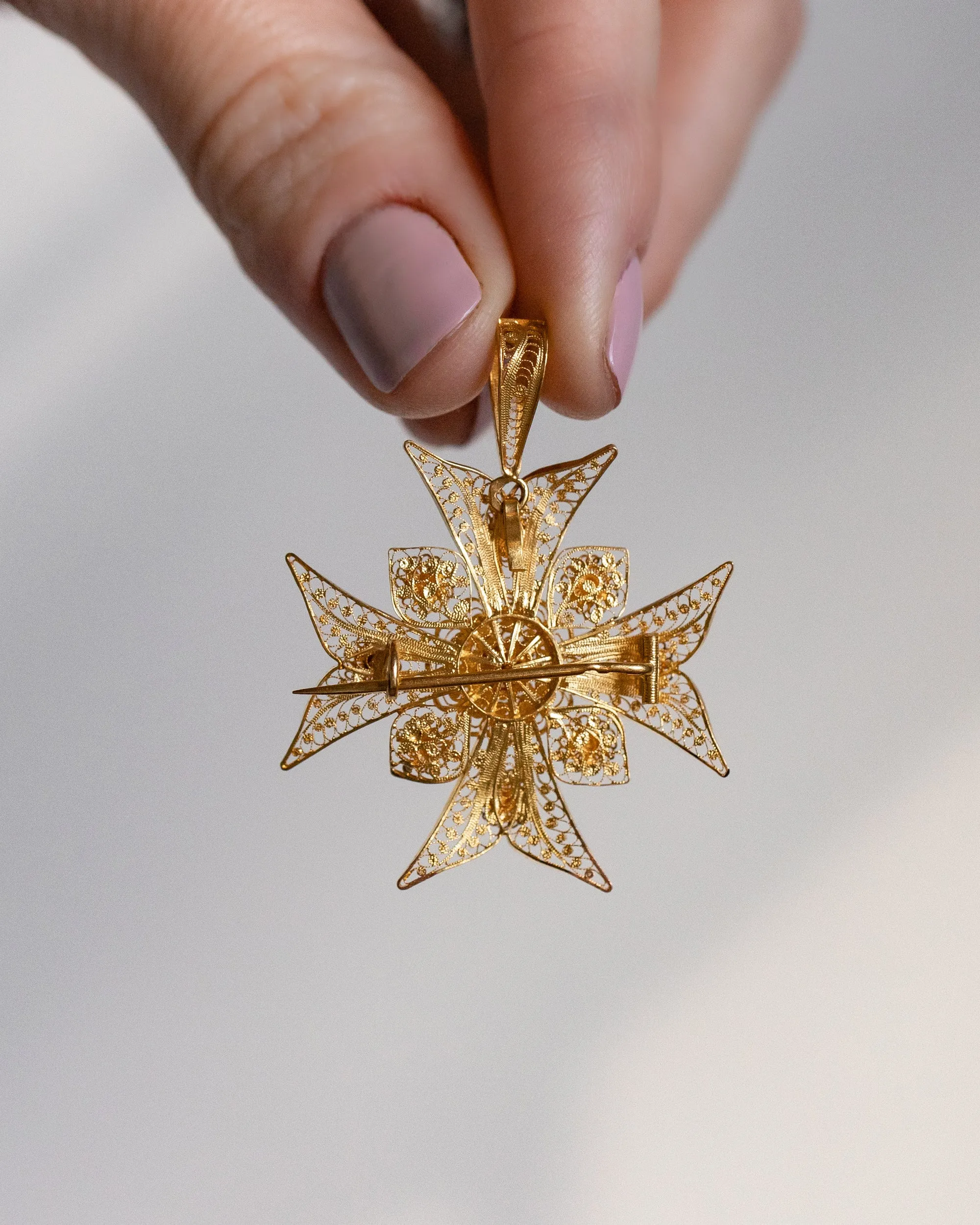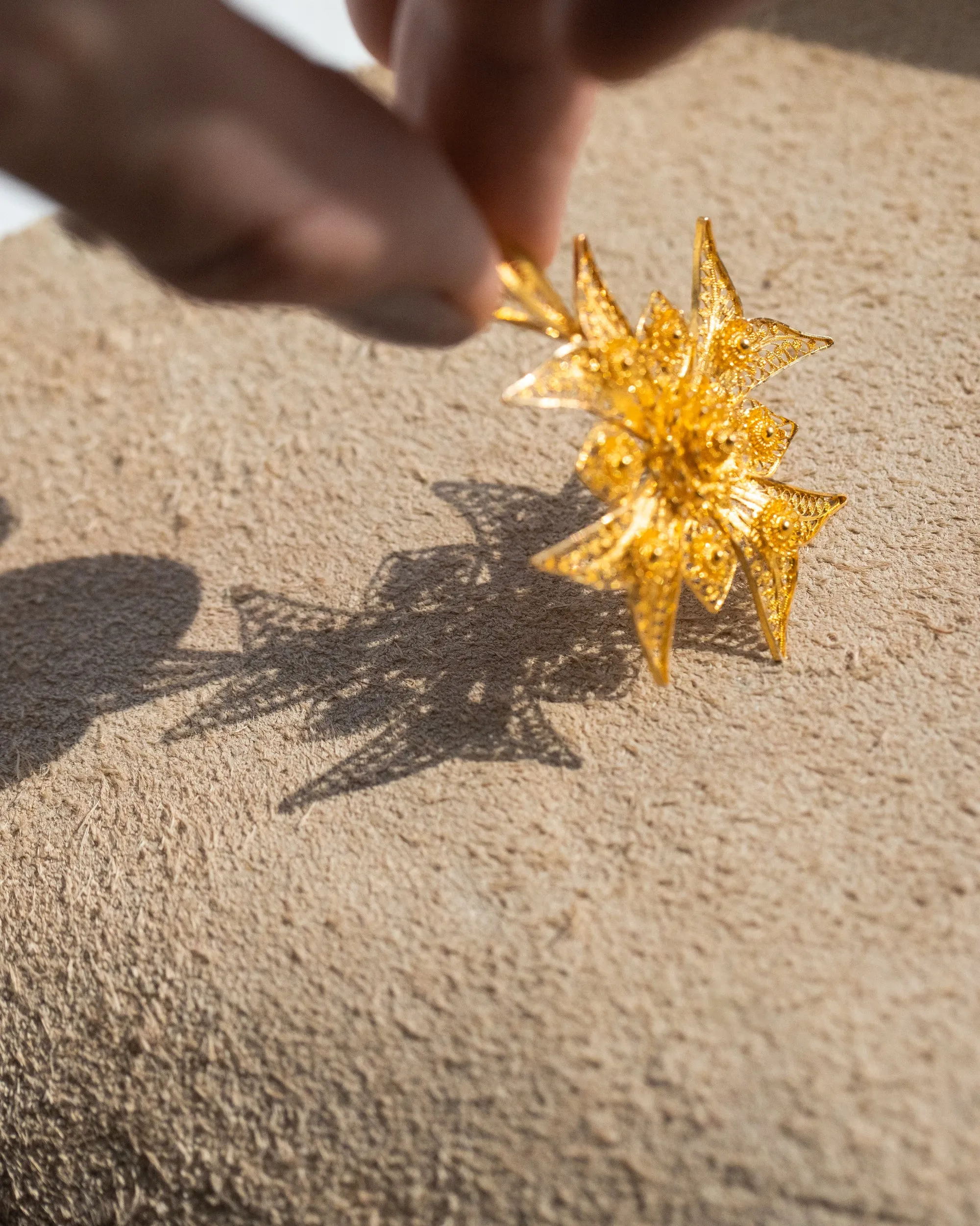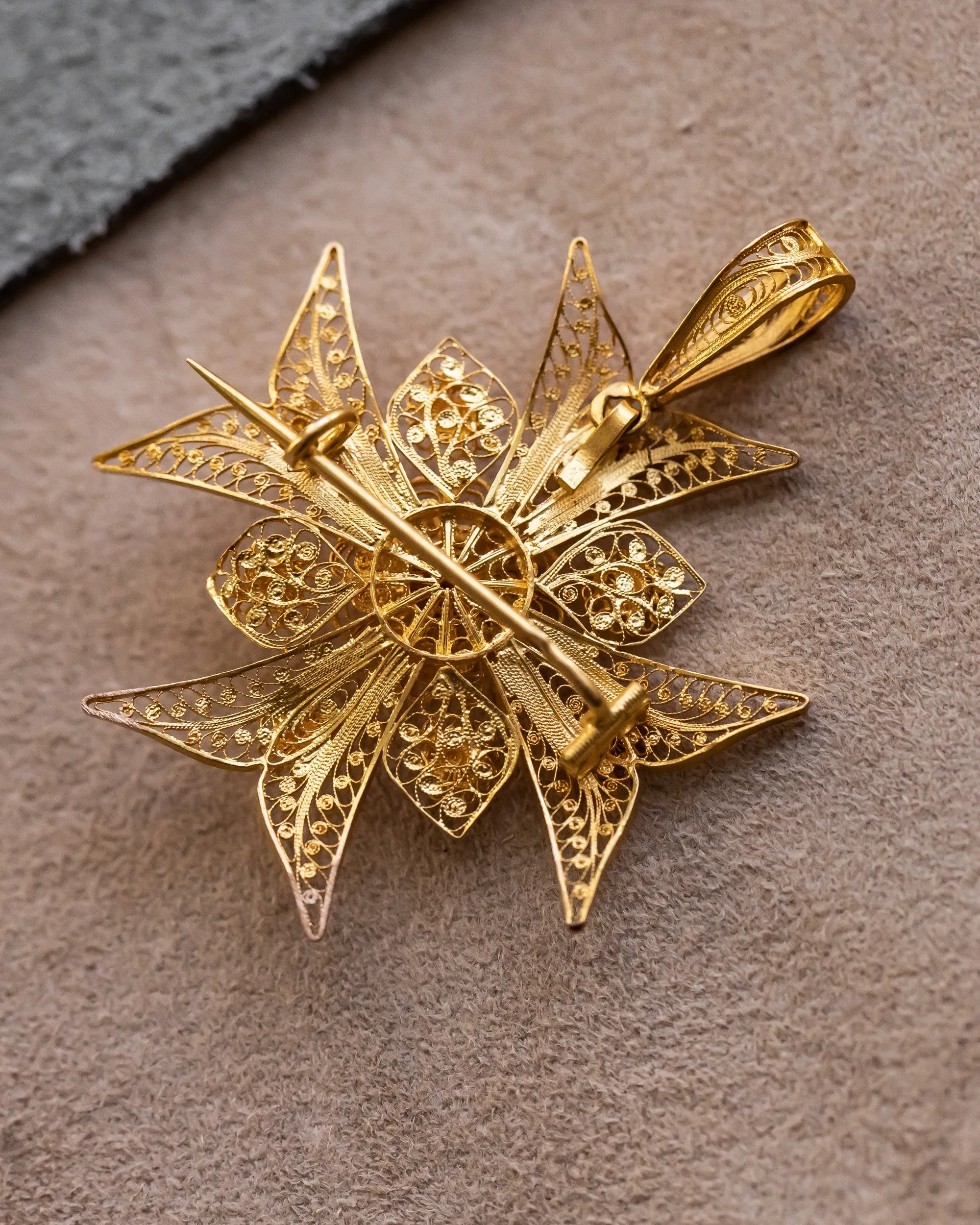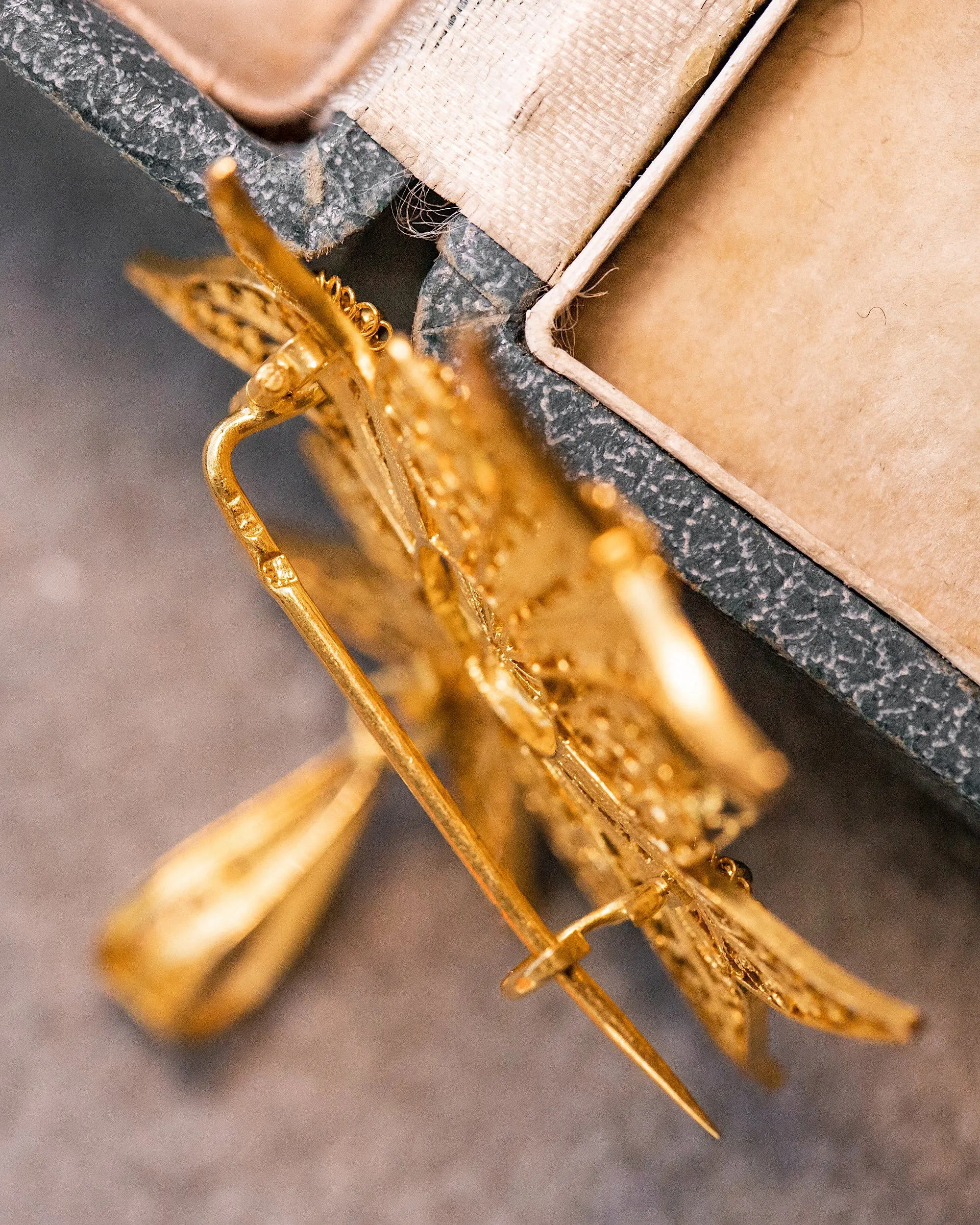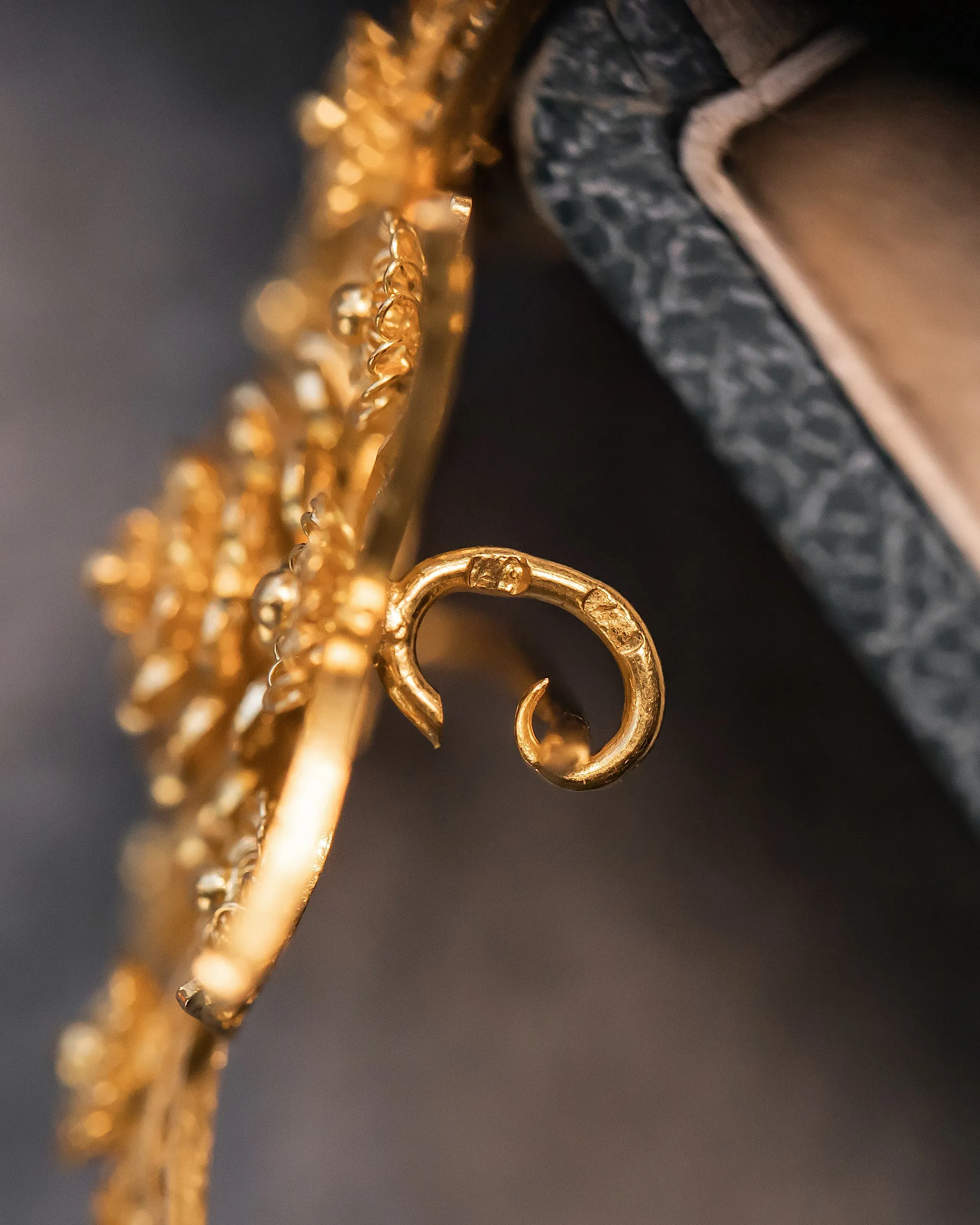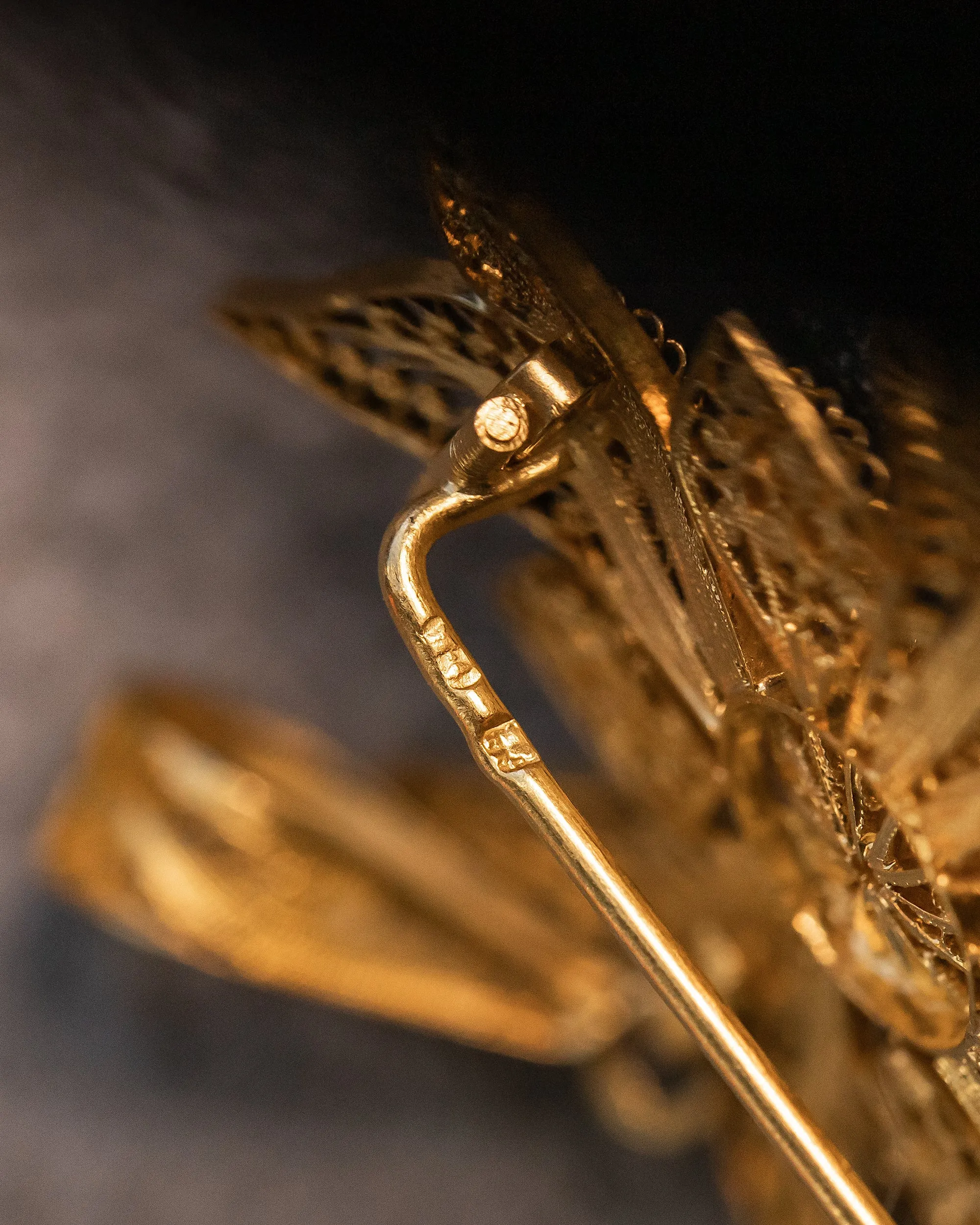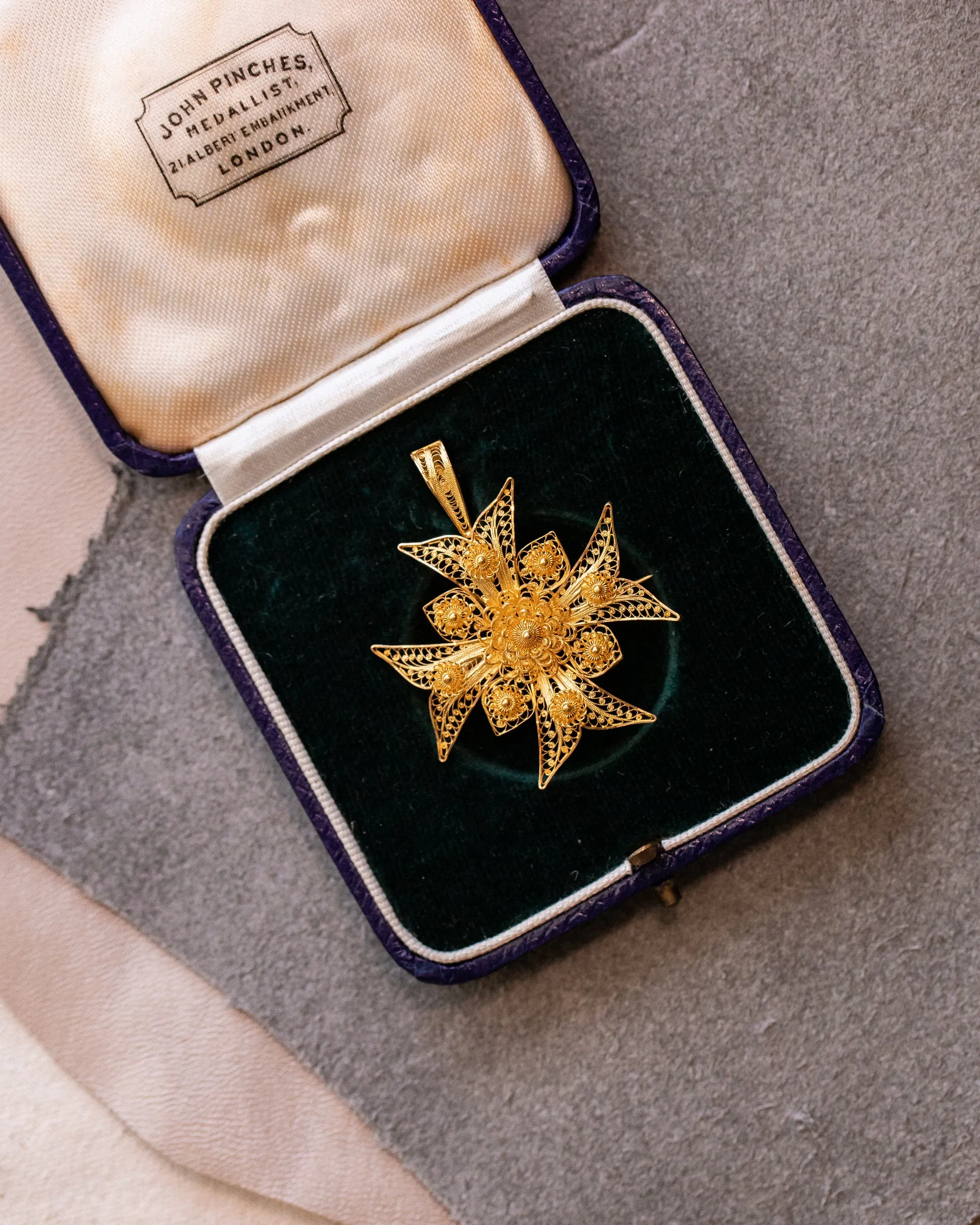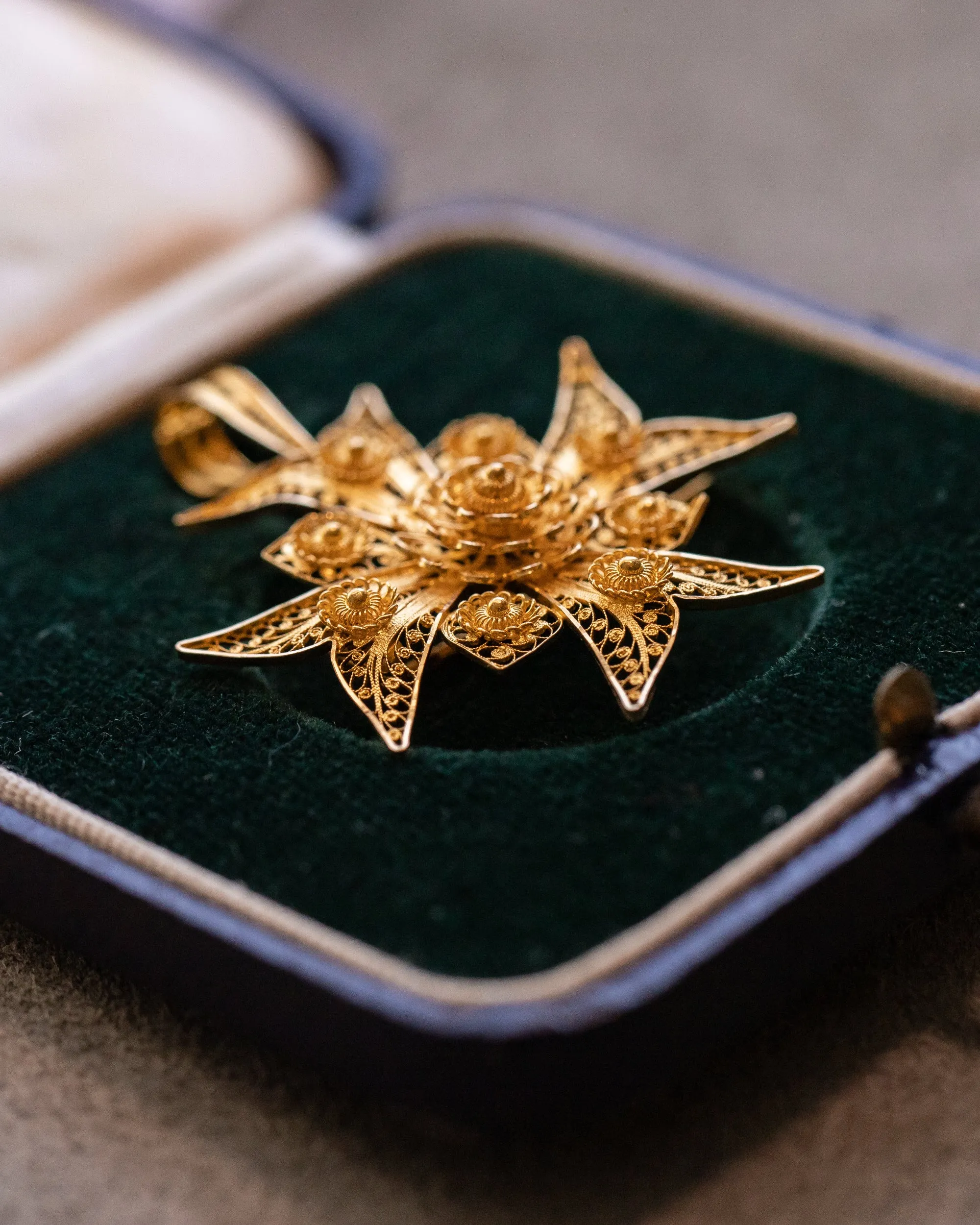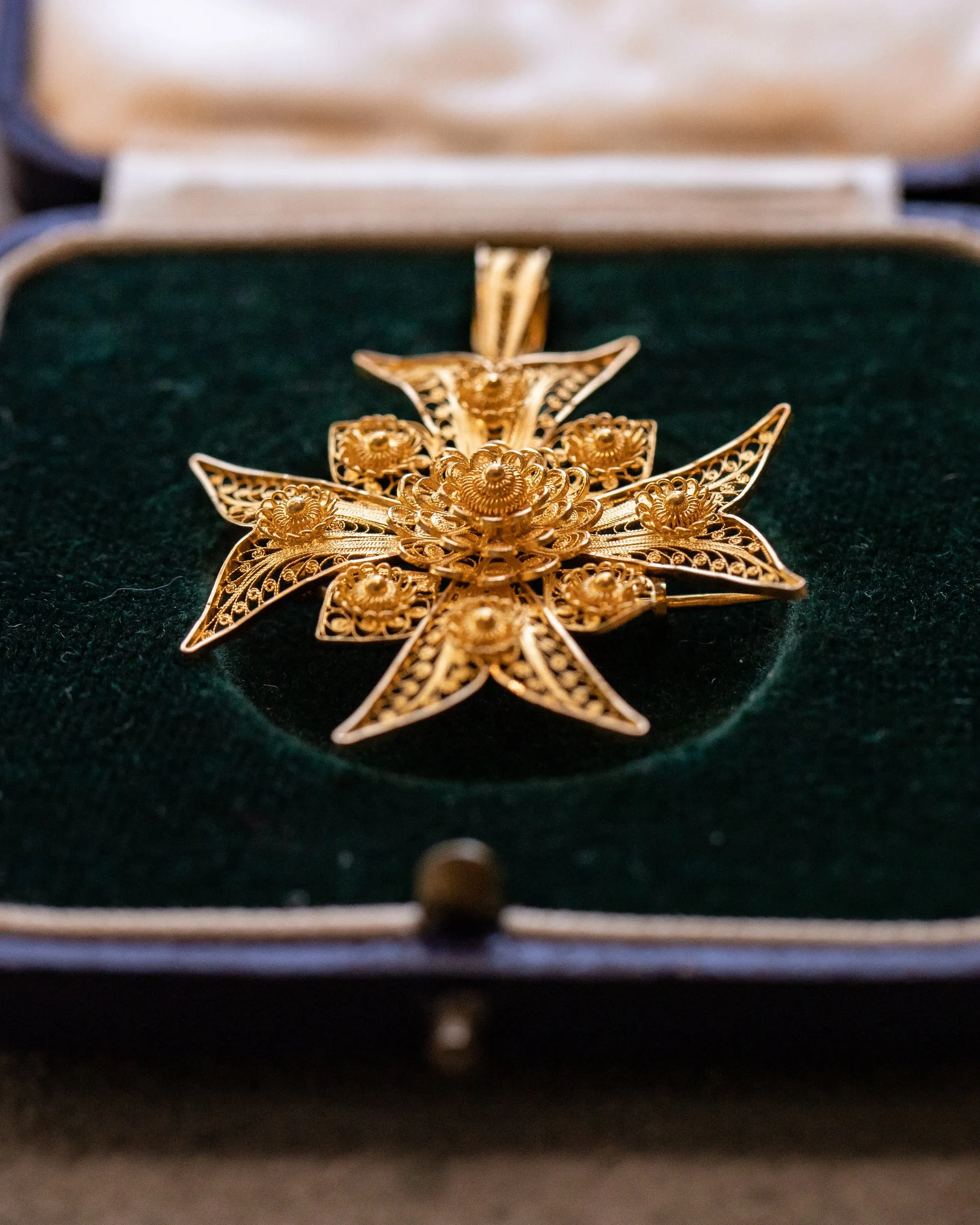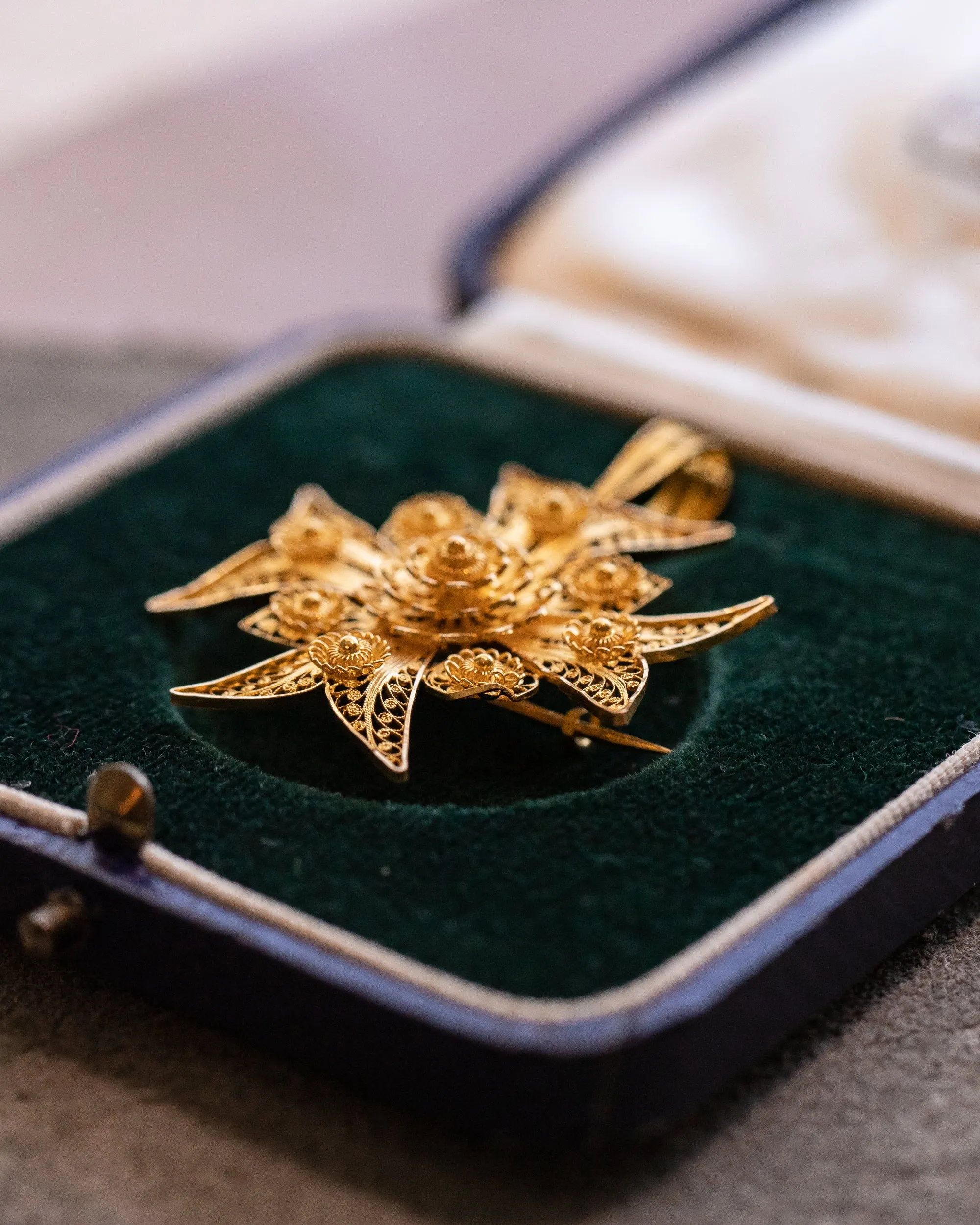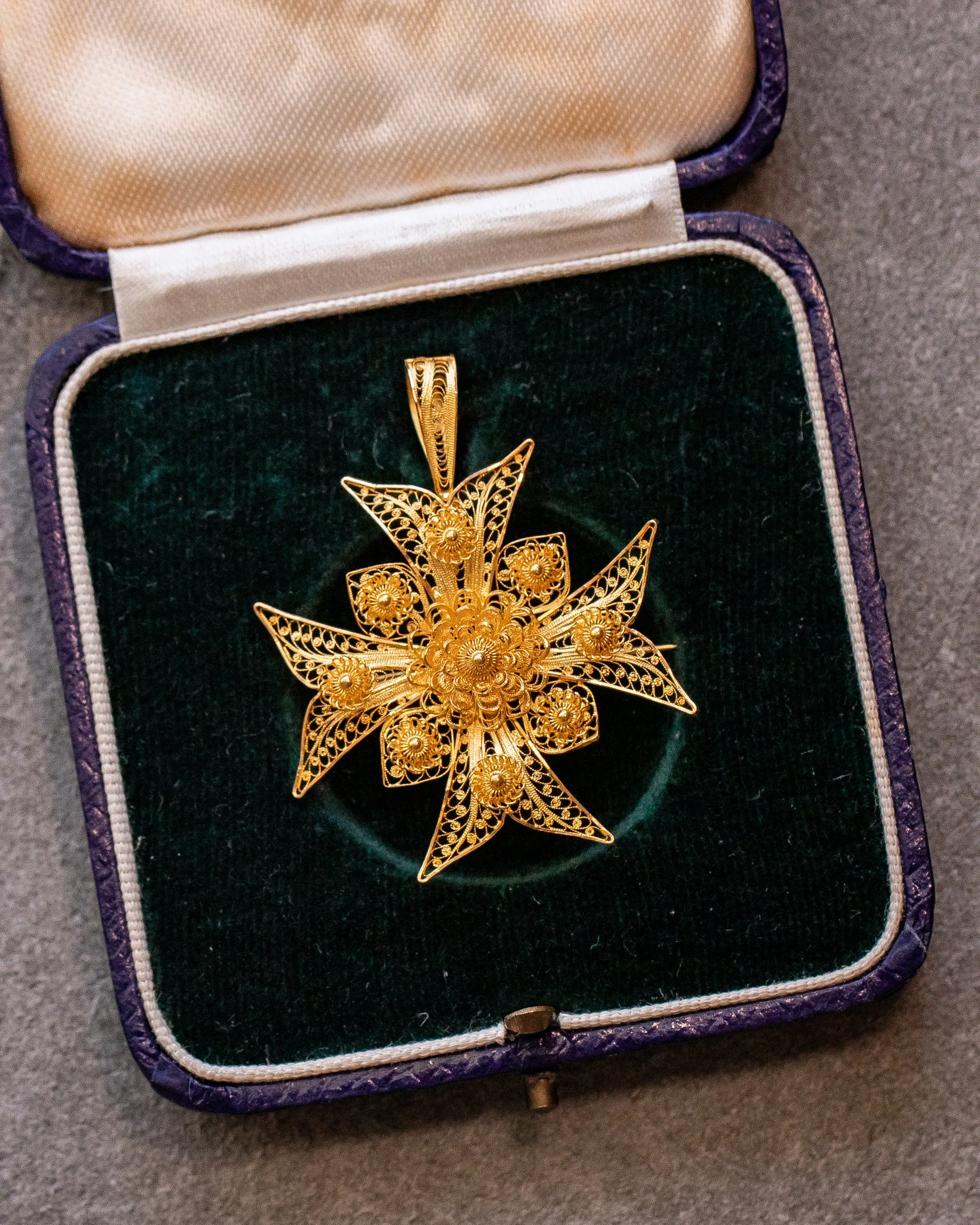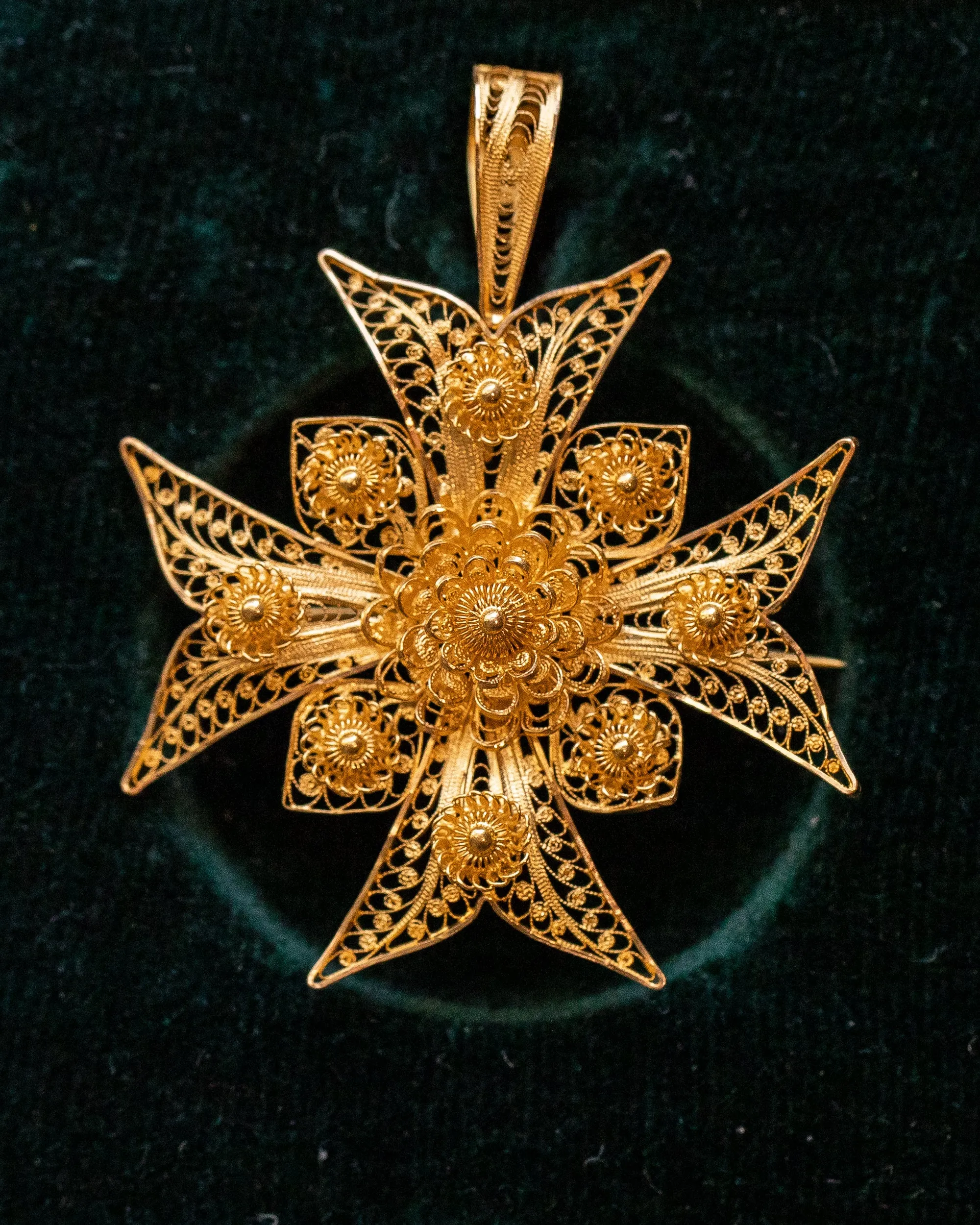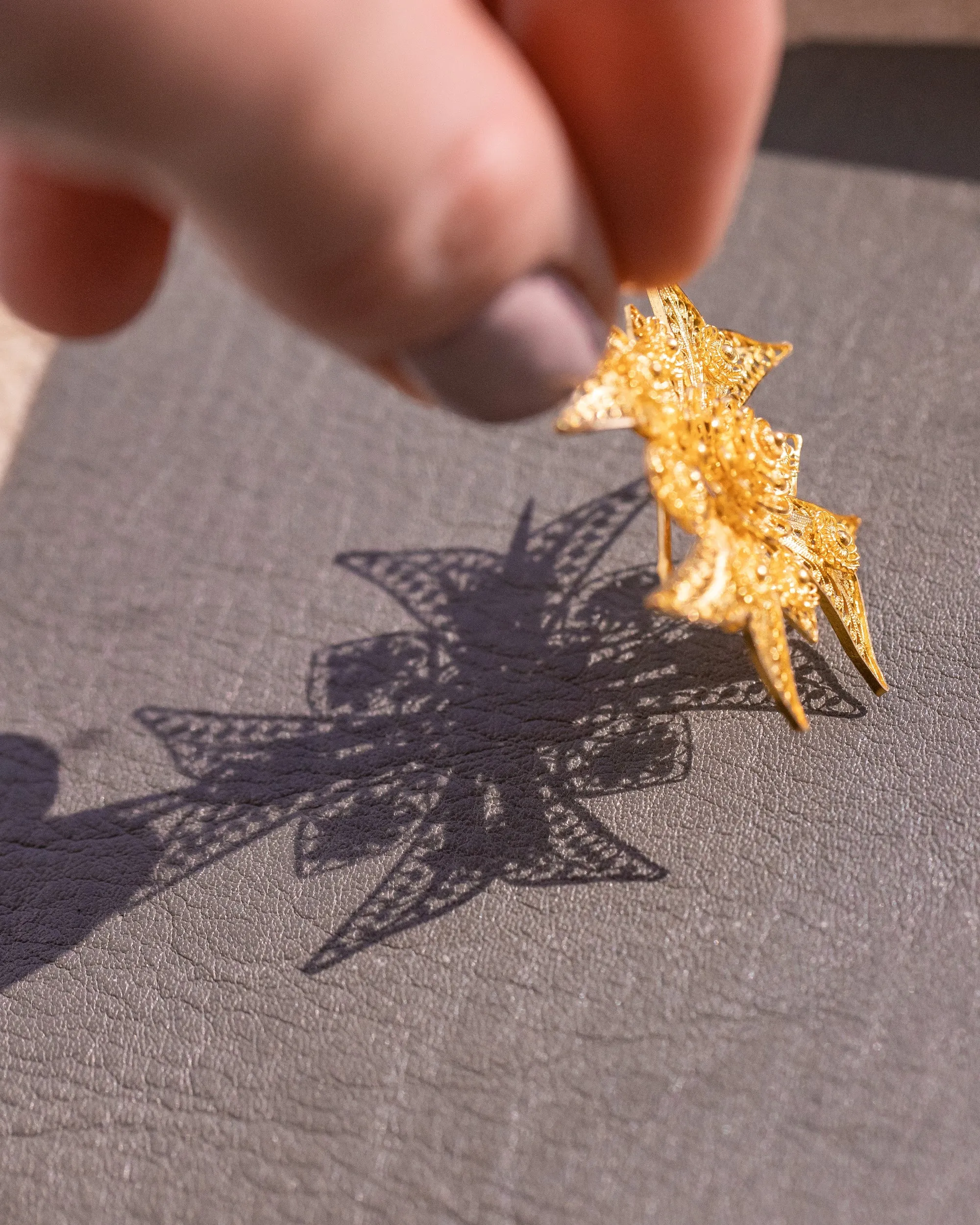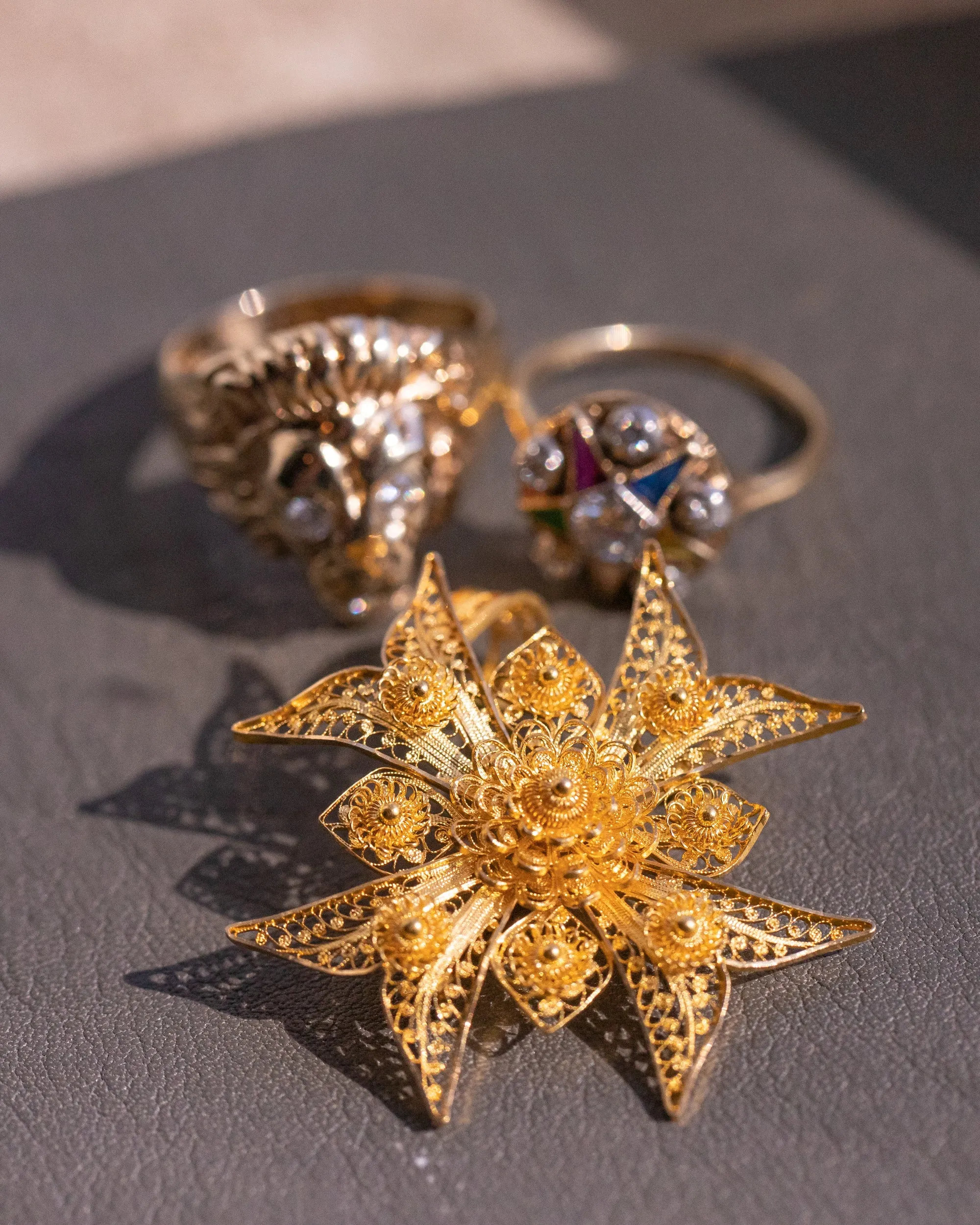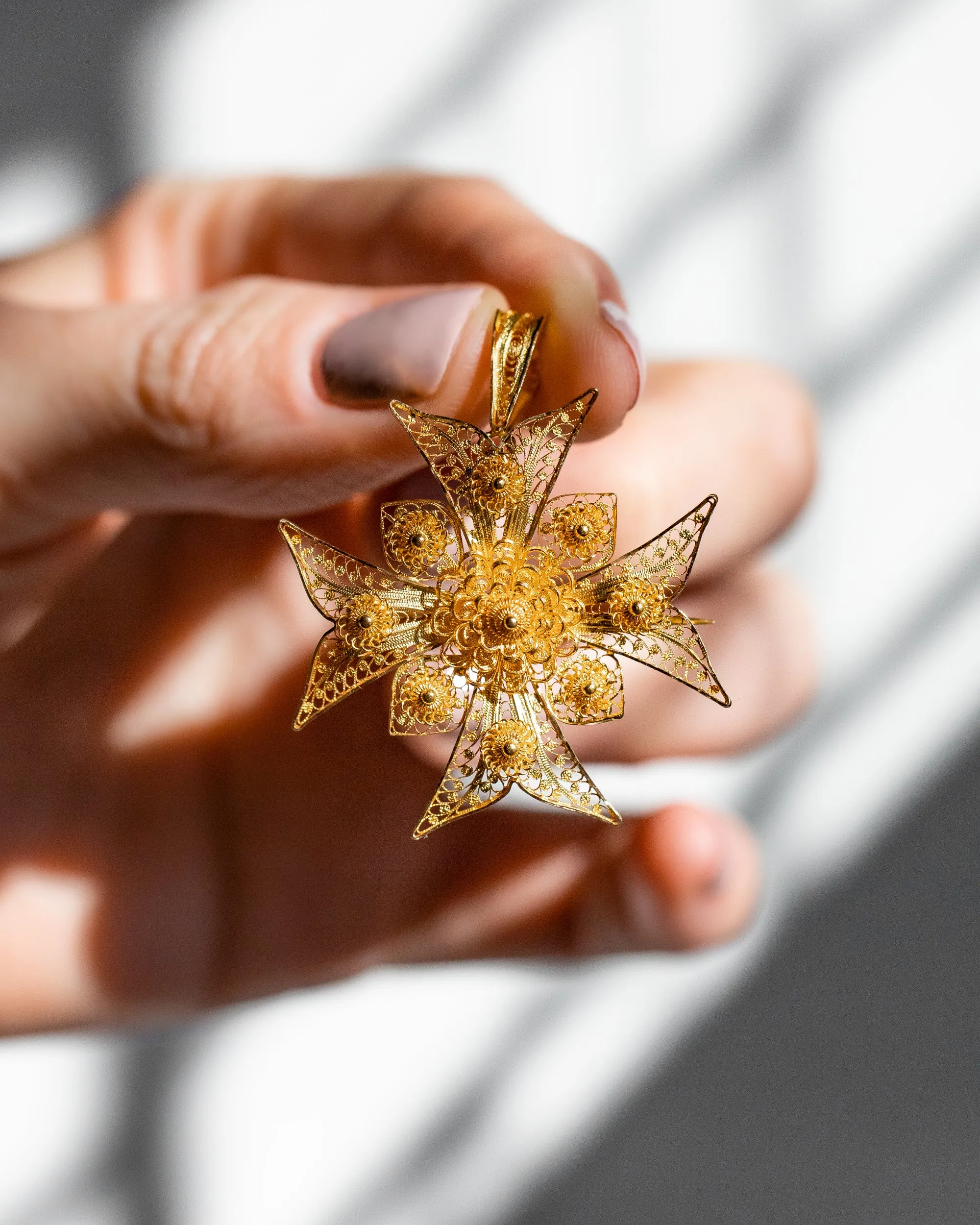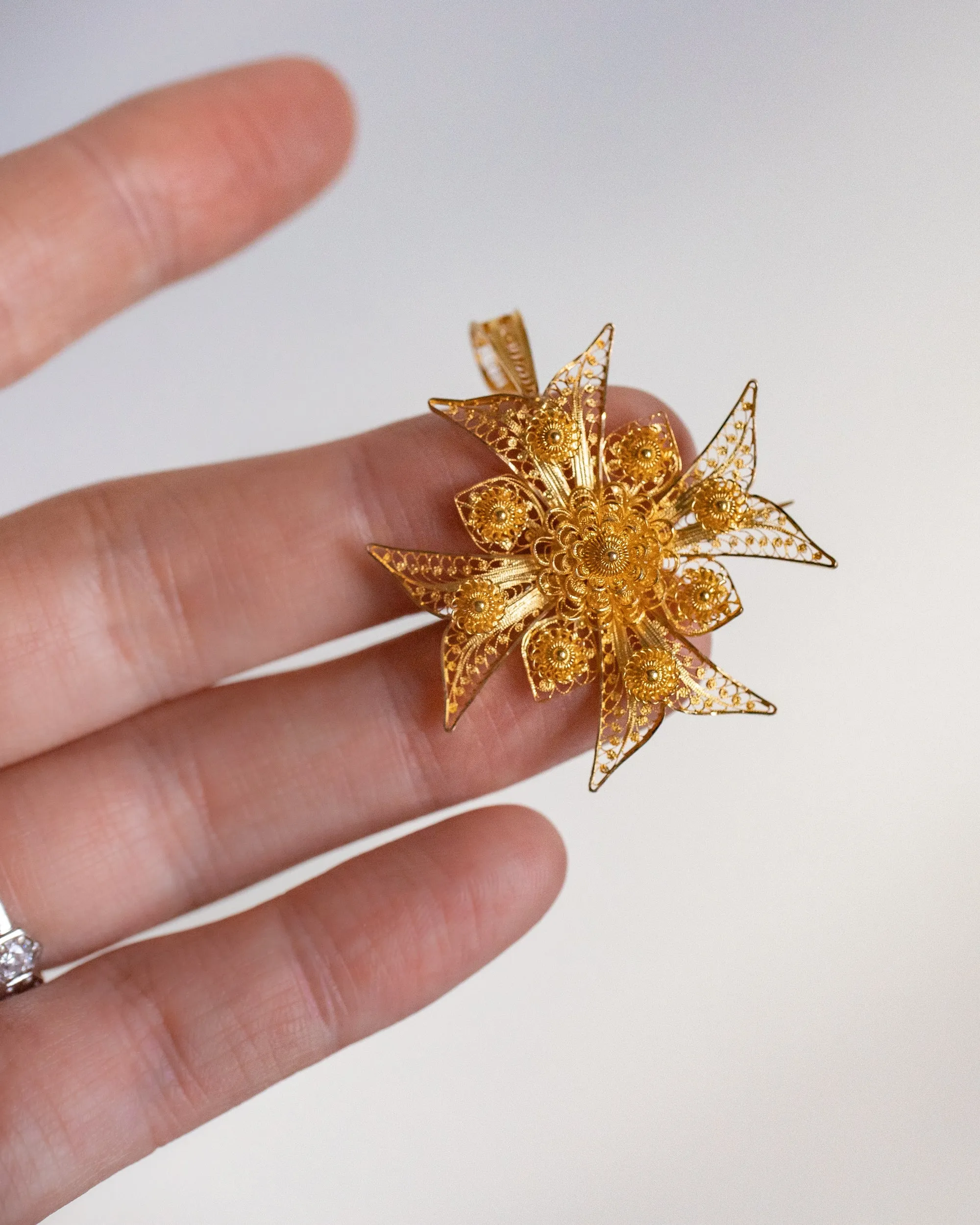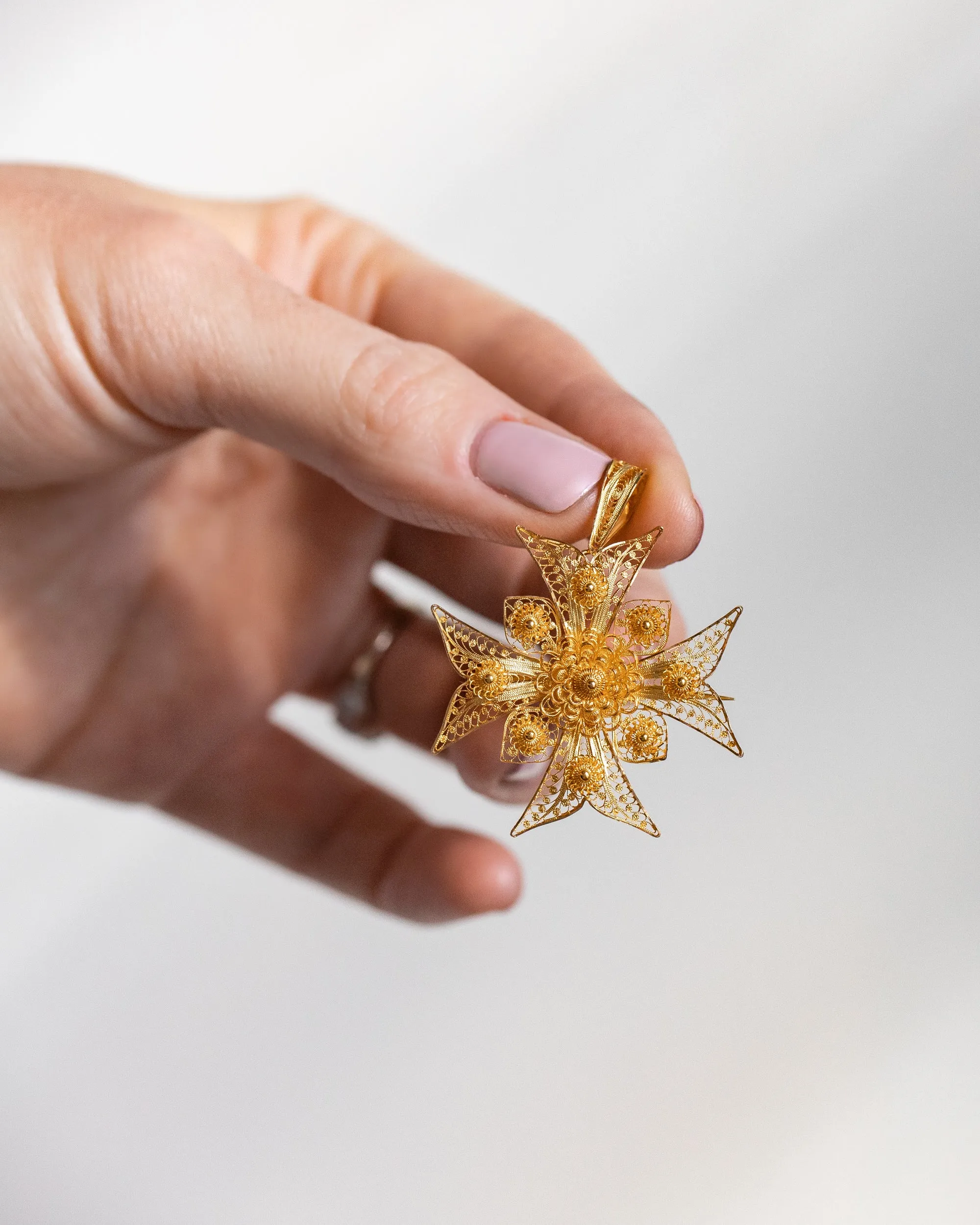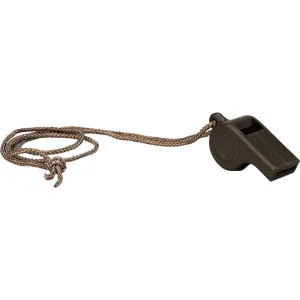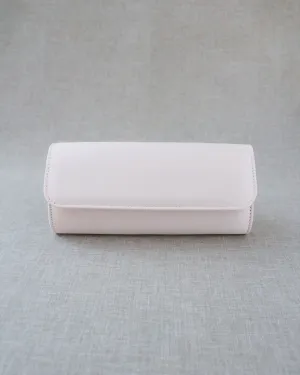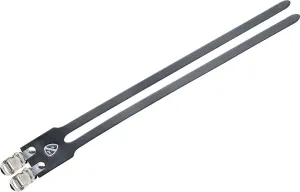General Information:
- Precious Metal Weight: 2.96 dwt
- Precious Metal Material: Acid tested by the shop's bench jeweler for at least 18k gold; possibly bears a bloomed gold finish which, by nature of the blooming process, is a top layer of pure, 24k gold.
- Dimensions: This piece measures 43.54 mm (1.7142 in) long including the bail (extended) x 34.04 mm (1.3402 in) wide x 10.75 mm (0.4232 in) deep including bail/c clasp to the reverse.
- Weight: A very nice 4.61 grams
- Markings: Hallmarks may be found on the open c-clasp, on the stem pin, and bail's jump ring loop. These are relatively worn and exceedingly small, but appear to be European, and are likely Portuguese.
- Era: This piece's construction type, gold components' purities, hand-wrought wirework cannetille, and cross-cultural socio-historical background indicate an estimated origin of the mid-19th century. Specifically, research suggests that this cross is from the Iberian Peninsula, and dates to between 1850 and 1870.
- Buyer Notes: An incredibly rare jewel with its only close comparables found within the Victoria & Albert Museum archives, this cross pendant is of notable distinction for its remarkable size, symbolism, beauty and history. Positively destined for the ultimate collector, this exceptional cross is nothing short of divine. Please kindly keep in mind that the high purity of this piece, in conjunction with the nature of wirework renders this jewel fairly pliable with the hands. Given this characteristic and the piece's rarity, it should be handled, stored, worn and enjoyed with care and discretion.
The Story:
The form of this cross denotes it as a Maltese cross, as indicated by its equidistant arms and identifiable forked ends. The Maltese shape has its original roots in insignia used by an order of monks known as the Knights of St. John of Jerusalem (also called the Knights Hospitaller). This monastic order was formally founded around 1099 and fought in the Holy Crusades that began in the High Middle Ages. The Crusades were a series of religious wars between European Christians and Muslims, categorized by historians into eight distinct Crusades, interspersed by several additional, albeit smaller campaigns:
- First Crusade (1096-1099)
- the People’s Crusade (1096)
- Second Crusade (1147-1149)
- Third Crusade (1189-1192)
- Fourth Crusade (1202-1204)
- the Albigensian Crusade (1209–1229)
- the Children’s Crusade (1212)
- Fifth Crusade (1217-1221)
- Sixth Crusade (1228–1229)
- Seventh Crusade (1248-1254)
- Eighth Crusade (1270)
The purpose, outcomes and consequences are vast and multitudinous, but they were fought partially in response to the Muslim wars of expansion, after which European Christians sought to secure and (re)control the holy cites of the Middle East and recover territories in those regions that had previously been under Christian dominion.
The Crusaders fought in the name of Christianity, under the banner of spreading the Christian faith, and resolved that such bloodshed and force was of redeeming value for their souls and resulted in spiritual expurgation of their sins. Given such perceived selfishly religious stakes, the Crusaders were utterly ruthless, manifesting generations of relational brokenness, cross-faith mistrust, and a mess of authoritative misappropriation. The consequences of the Crusades are still hotly debated, and their lessons continue to be reviewed and examined. Yet, those wars were definitive of an entire age of history, resulting in ever-deepening dissension between Western and Roman Catholic beliefs, and characterizing the intricacies of religious, literary, governmental and social culture across a large portion of the globe and all the diverse inhabitants therein.
Like all significant events within history, the effects of the wars and their purported purposes shaped other seemingly disparate sectors of culture, including but certainly not limited to the decorative and wearable arts, such as jewelry and the status symbols they inevitably are.
Returning to uncovering the origins of the Maltese cross itself, one must regard the history of the monastic Knights of Saint John: The order was founded in Jerusalem by monks whose sole mission was to care for ill pilgrims in the area, regardless of their professed faith. By the year 1080, just a few years before the outbreak of the First Crusade aimed at overthrowing Muslim rule of the Holy Land, the order had already established a hospital in the city of Jerusalem, thus their alternative title of Knights Hospitaller. The onset of the Crusades and the constant besieging and upheaval that ensued also provoked the centuries-long relocation quest for the militant monastic order, which moved them eastward from Jerusalem to Acre, to Cyprus then Rhodes. By 1530, Holy Roman Emperor Charles V granted the Knights of Saint John the island of Malta, where they established their center of operations and from which they sentineled the Mediterranean.
Save for a Ottoman invasion in 1565, the order was able to thrive in Malta until famed General Napoleon Bonaparte captured the island in 1798 near the end of the French Revolution. Bonaparte's confiscation came with relatively little resistance, and was intended as a doorway into the seizure of Egypt, India and other British colonies of the Far East. With the French invasion came the end of the Hospitaller's 268-year long rule of the Maltese archipelago, and the French were quick to dismantle the Roman Catholic institutions within. Outraged, a growing insurgent native population rose up against the French occupation, and aided by the British, the Maltese Uprising successfully launched a naval blockade which interdicted and disorganized the lines of communication at sea. Thus, Bonaparte's intentions were stymied and needed supplies could not be replenished, leading to starvation, disease and inevitable defeat. By September 5, 1800, the French surrendered Malta into the hands of the British.
As a sign of great pride and patriotism, the British people donned the Maltese cross in a show of power. While Latin style cross jewels were long popular in Europe, the Maltese style cross rose to favor in England, specifically, at the end of the Georgian era between 1800 and 1830 due to these events and as a sign of solidarity with the British fight to vanquish Napoleonic France.
London-based magazine, La Belle Assemblée (or Bell's Court and Fashionable Magazine) was a leading publication established in 1806, and was geared toward an Englishwoman audience. In it, wonderfully detailed fashion plates kept readers abreast of current trends and styles, including the very latest in jewelry vogue. Famed Lady Hamilton (born Amy Lyon), the wife of fleet commander Sir William Hamilton, was featured in the magazine for her fashion and choice of a Maltese jewel. No doubt her standing as an influential British aristocrat with enviable taste ensured the widespread endorsement of such jewelry, which in turn, meant that the symbolic Maltese cross prevailed as an ornamental gesture of national loyalty and a display of posh elitism amongst the most sophisticated gentry.
A June 1809 excerpt from La Belle Assemblée reads as follows:
“EVENING or FULL DRESS. A white underdress of gossamer satin, embroidered at the feet and round the bottom of the sleeves with a laurel border of pale blue or pea-green foil. A Galician robe, with demi-train of pale blue or pea-green crape, vellum gauze or leno; the edges finished with broad double foldings and cord. A full Circassian sleeve, looped with with Cornelian brooches and cord; loose triangular bosom, ornamented at the central point with a correspondent tassel. A short pointed drapery flowing from the right shoulder towards the knee, rounded on the left, and festooned near the bottom with bows or rosettes the colour of the robe. A small French tippet, or half-handkerchief of lace, thrown negligently across the back and falling over the left shoulder. The Austrian helmet hat of white satin, with laurel border and spray, in pale blue or pea-green foil; a round white feather, frosted with silver, drooping towards the right side. A gold elastic neck chain, with Maltese cross of Carnelian and pearl. Hoop earrings, armlets, and bracelets to correspond. Slippers of pale blue or pea-green kid, and [white gloves] rucked below the elbow. White Opera fan of crape, wrought in antique devices in silver.” Please see the accompanying fashion plate for this description here.
While the Maltese cross design was most popular during the Georgian period, its favorability reemerged here and there throughout the 19th century. As such, examples of Maltese cross jewelry (as opposed to military regalia or medals, in this instance) can be found all the way to the turn of the century, though the construction method, metal content, aesthetic nature and hallmarks of such pieces all assist in dating them with greater exactitude. The Maltese cross that is offered herein is likely of Portuguese origins, and is specifically likely made by the goldsmiths of Gondomar. The beautiful wirework and gleaming gold appeal of the goldsmiths from this region is precisely what makes their jewels so sought after today, and is indeed what made them so desired by travelers to the area in the mid Victorian period. Even in 1872, their work was proudly displayed for sale at the London Exhibition. A remarkably similar example, inclusive of a neck chain, may be found in the Victoria & Albert Museum collections here. Two other similar crosses in the V&A Museum archive feature varying arm shapes, bulkier silhouettes, and silver fabrication, though showcase correlative rosettes; see these crosses here and here. Research suggests, therefore, that this cross is of the Iberian Peninsula, and dates to between 1850 and 1870.
With this cross' likely Portuguese creation, it may very well bear a 19 karat or higher purity, as Portuguese smithing is known for. This piece acid tests for at least 18 karats, and indeed passes the 22 karat test. However, we are conservatively noting it as at least 18k gold. Its immaculately bright gold chroma is an absolute standout amongst the crosses on the market, and heralds this accessory as uniquely sumptuous in craftsmanship and purity. It may be worn as a statement pendant or as a brooch, as it is cleverly equipped with findings for both options.

